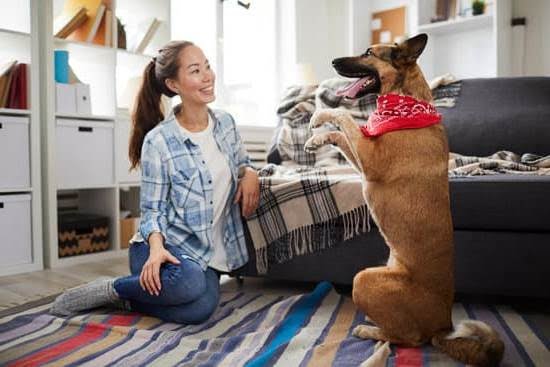Are you wondering what age to train your dog on an invisible fence? Training a dog on an invisible fence is a crucial part of their development and safety. In this article, we will explore the ideal age to begin training, understanding the developmental stages of dogs, factors to consider, training techniques, common mistakes to avoid, and the importance of ongoing monitoring and adjusting.
An invisible fence is an underground boundary that uses a collar with a receiver to keep your dog within designated boundaries without the need for a physical barrier. This technology offers numerous benefits for pet owners, providing a safe and effective way to contain and train their dogs while allowing them the freedom to roam within specific areas.
Understanding the developmental stages of dogs is essential in determining the right age to start training them on an invisible fence. Different stages of a dog’s life can have varying impacts on their ability to grasp the concept of boundaries and discipline. Factors such as breed, size, and behavior also play significant roles in determining when it is appropriate to begin training your dog on an invisible fence.
Understanding the Developmental Stages of Dogs
Puppyhood
During the first few months of a dog’s life, they go through a crucial stage of development. This period, usually ranging from 8 weeks to 6 months, is known as puppyhood. At this stage, puppies are curious, energetic, and eager to explore their surroundings. It is important to introduce them to the concept of an invisible fence during this time so that they can develop an understanding of boundaries early on.
Adolescence
As dogs enter their adolescent stage, which typically occurs between 6 months to 2 years of age, they may become more independent and stubborn. Training during this phase can be challenging, but it is important to reinforce the boundaries established by the invisible fence consistently. This will help in shaping their behavior and preventing them from testing the limits as they grow older.
Adulthood
Once dogs reach adulthood, around 2 years of age and beyond, they tend to become more settled and less impulsive. While training on an invisible fence can still be effective during this stage, it may take longer for older dogs to adapt compared to puppies. However, with patience and consistent reinforcement, adult dogs can also learn to respect the boundaries set by the invisible fence.
Considering these developmental stages is crucial in determining the ideal age to begin training a dog on an invisible fence. Each stage presents its own set of challenges and opportunities when it comes to training, making it important for pet owners to understand how a dog’s age can impact their ability to grasp the concept of an invisible fence.
Ideal Age to Begin Training
The ideal age to begin training a dog on an invisible fence is an important consideration for pet owners looking to ensure the safety and security of their canine companions. The use of invisible fences has become increasingly popular as a tool for training dogs to stay within a designated area without the need for physical barriers. However, determining the right age to start training is crucial for the effectiveness of this method.
Puppies typically start learning about boundaries and territory as early as 6 weeks old, making it an ideal time to introduce them to the concept of an invisible fence. While they may not be physically ready to be contained by the fence at this age, laying down the groundwork for their understanding of boundaries can significantly aid in their later training.
It’s important to note that individual dogs may vary in their development and readiness for invisible fence training. Some larger breeds may take longer to fully understand and respect boundaries, while smaller or more obedient breeds might catch on more quickly. It’s best to consider a dog’s individual personality, as well as breed tendencies and behavioral traits when determining the most appropriate age for training on an invisible fence.
| Age | Training Recommendation |
|---|---|
| 6-8 weeks | Lay down the groundwork for understanding boundaries |
| 4-6 months | Begin formal training with supervision |
| 1 year and older | Mature enough for full off-leash containment with proper guidance |
In addition to age, it’s also important to consider a dog’s behavior and ability to respond to commands. As such, starting formal training around the age of 4-6 months when puppies are more able to understand basic commands can be highly effective. By providing consistent supervision during this stage, pet owners can guide their dogs through gradual exposure and ensure a smooth transition into off-leash containment within the boundaries set by the invisible fence system.
Factors to Consider
Training a dog on an invisible fence is a decision that requires careful consideration, taking into account various factors that may influence the timing of training. When determining what age to train a dog on an invisible fence, it is important to consider the breed, size, and behavior of the dog. Each of these factors plays a significant role in identifying the ideal age to begin training.
- Breed: Different dog breeds have unique characteristics and tendencies that can impact their response to training on an invisible fence. Some breeds may require more time and patience during the training process, while others may be quick learners. Understanding the specific traits of your dog’s breed can help in determining the appropriate age to start training.
- Size: The size of a dog also plays a role in when to begin training on an invisible fence. Smaller dogs may need to be trained at a younger age due to their size and potential vulnerability, while larger dogs may be able to start training at a slightly later stage of development.
- Behavior: A dog’s behavior and temperament are crucial considerations when deciding when to initiate training on an invisible fence. Dogs with more independent or stubborn personalities may require additional time and effort during the training process compared to dogs with more compliant or obedient dispositions.
Considering these factors will aid in determining what age is appropriate to commence training your canine companion on an invisible fence, ensuring that they are adequately prepared for this form of boundary training. By taking into account these elements, pet owners can set their furry friends up for success while utilizing this effective method of containment and protection.
Training Techniques
When training a dog on an invisible fence, it is crucial to use the right techniques to ensure that your furry friend learns and respects the boundaries. Here are some effective methods and tips for training your dog on an invisible fence at the appropriate age:
1. Positive Reinforcement: Use treats, praise, and affection to reward your dog for staying within the boundaries of the invisible fence. This will help them associate good behavior with positive outcomes.
2. Gradual Introduction: Begin by introducing your dog to the invisible fence gradually. Allow them to wear the collar without activating the system to get used to wearing it. Then, introduce them to the boundary line with supervision and guidance.
3. Consistent Training Schedule: Establish a consistent training schedule for your dog, ensuring regular sessions that are not too long or overwhelming for your pet.
4. Supervision: Always supervise your dog during training sessions on the invisible fence to ensure their safety and proper adherence to boundaries.
5. Professional Assistance: If you’re unsure about how to train your dog on an invisible fence, consider seeking professional assistance from a dog trainer experienced in using this type of containment system.
By implementing these techniques, you can effectively train your dog on an invisible fence at the right age, providing them with a safe and secure environment while allowing them freedom within set boundaries.
Common Mistakes to Avoid
When it comes to training a dog on an invisible fence, there are a few common mistakes that pet owners should be aware of in order to ensure the training process goes smoothly. Understanding these potential errors and how to avoid them can greatly contribute to the success of training your dog on an invisible fence.
Inconsistent Training
One common mistake that many pet owners make when training their dogs on an invisible fence is being inconsistent with the training process. It is important to establish a consistent routine and set of expectations for your dog in order for them to understand and respect the boundaries of the invisible fence. Inconsistency in training can confuse your dog and hinder their ability to learn and follow the rules.
Using Fear-Based Training Techniques
Another critical mistake to avoid when training your dog on an invisible fence is using fear-based or punishment-based training techniques. This can create anxiety and fear in your dog, leading to negative associations with the invisible fence and potentially causing other behavioral issues. Instead, focus on positive reinforcement techniques such as rewarding your dog with praise, treats, or toys when they exhibit desirable behavior.
Neglecting Ongoing Supervision and Adjustment
Finally, neglecting ongoing supervision and adjustment during the training process can also be detrimental. As your dog grows and develops, their understanding of boundaries may change, requiring adjustments to the invisible fence parameters. Additionally, consistent monitoring allows you to identify any potential issues or challenges early on and address them proactively.
By avoiding these common mistakes and implementing effective training techniques, pet owners can successfully train their dogs on an invisible fence at the appropriate age, ensuring the safety and well-being of their beloved pets.
Monitoring and Adjusting
The training process for an invisible fence involves more than just initial training. It is essential to continually monitor and adjust the training to ensure its effectiveness and the safety of your dog. Ongoing supervision is crucial as it allows you to observe your dog’s behavior and make necessary adjustments to the training plan.
One of the key reasons why ongoing supervision is vital is that dogs may exhibit different behaviors as they mature. What works for a younger dog may not be effective for an older one. Therefore, regularly monitoring your dog’s response to the invisible fence can help identify any changes in behavior and make appropriate adjustments to the training approach.
In addition, environmental factors can also impact the effectiveness of an invisible fence. For example, changes in landscaping or neighborhood activity may affect how a dog responds to the boundaries set by the fence. By consistently monitoring the dog’s behavior in relation to these external factors, pet owners can make necessary adjustments to maintain the efficacy of the invisible fence.
Lastly, ongoing supervision and adjustments during the training process also serve as an opportunity for pet owners to reinforce positive behavior and address any issues that may arise. This consistent involvement helps build a strong bond between owner and pet, leading to better overall obedience and success with using an invisible fence.
| Importance of Ongoing Supervision | Adjustments During Training Process |
|---|---|
| Allows for observation of dog’s behavior | Identify changes in behavior |
| Environmental factors impact effectiveness | Maintain efficacy of invisible fence |
| Opportunity to reinforce positive behavior | Address any issues that may arise |
Conclusion
In conclusion, training a dog on an invisible fence is an important aspect of their overall behavioral development and safety. Understanding the developmental stages of dogs is crucial when determining the ideal age to start the training process.
It is recommended to begin training a dog on an invisible fence around 6 months of age, as they are more likely to understand and retain the training at this stage. However, factors such as breed, size, and behavior should also be taken into consideration when determining the appropriate age for training.
Additionally, employing effective training techniques is essential for successfully introducing a dog to an invisible fence. Consistency, positive reinforcement, and patience are key elements in the training process. It is important to avoid common mistakes such as inconsistent training and not properly supervising the dog during the initial phase of using the invisible fence.
Ultimately, ongoing monitoring and adjustments are critical once a dog has been trained on an invisible fence. This ensures that they continue to understand and respect their boundaries.
Training a dog on an invisible fence at the right age sets them up for a safe and well-adjusted life within their designated area while allowing them the freedom to roam within those boundaries. By considering all these factors and guidelines, dog owners can establish a successful and beneficial invisible fence training experience for their furry companions.
Frequently Asked Questions
At What Age Can a Puppy Use an Electric Fence?
Puppies should be at least 8 weeks old before being trained to use an electric fence. This is to ensure that they are physically and emotionally ready for the training process.
When Can Puppies Be Trained on Invisible Fence?
Puppies can be trained on an invisible fence once they are old enough to understand basic commands, usually around 14-16 weeks of age. It’s important to gradually introduce them to the concept of boundaries and give them time to learn.
Is Invisible Fence Good for Puppies?
An invisible fence can be a good option for puppies if used responsibly. It can provide them with the freedom to play and explore while keeping them safe within the boundaries of your property. However, proper training and supervision are crucial for their safety and well-being.

Welcome to the blog! I am a professional dog trainer and have been working with dogs for many years. In this blog, I will be discussing various topics related to dog training, including tips, tricks, and advice. I hope you find this information helpful and informative. Thanks for reading!





